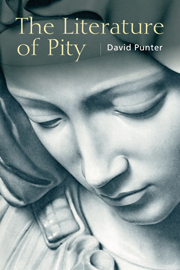Book contents
- Frontmatter
- Contents
- Plates
- Preface
- Acknowledgements
- 1 Distinguishing Pity
- 2 Pity and Terror: The Aristotelian Framework
- 3 Pietà
- 4 Shakespeare on Pity
- 5 The Eighteenth Century
- 6 Blake: ‘Pity would be no more …’
- 7 Aspects of Victoriana
- 8 Chekhov and Brecht: Pity and Self-Pity
- 9 ‘War, and the pity of War’: Wilfred Owen, David Jones, Primo Levi
- 10 Reflections on Algernon Blackwood's Gothic
- 11 Pity's Cold Extremities: Jean Rhys and Stevie Smith
- 12 Reclaiming the Savage Night
- 13 ‘Pity the Poor Immigrant’: Pity, Diaspora, the Colony
- 14 Lyric and Pity
- After Thought: Under the Dome
- Notes
- Bibliography
- Index
12 - Reclaiming the Savage Night
Published online by Cambridge University Press: 05 September 2014
- Frontmatter
- Contents
- Plates
- Preface
- Acknowledgements
- 1 Distinguishing Pity
- 2 Pity and Terror: The Aristotelian Framework
- 3 Pietà
- 4 Shakespeare on Pity
- 5 The Eighteenth Century
- 6 Blake: ‘Pity would be no more …’
- 7 Aspects of Victoriana
- 8 Chekhov and Brecht: Pity and Self-Pity
- 9 ‘War, and the pity of War’: Wilfred Owen, David Jones, Primo Levi
- 10 Reflections on Algernon Blackwood's Gothic
- 11 Pity's Cold Extremities: Jean Rhys and Stevie Smith
- 12 Reclaiming the Savage Night
- 13 ‘Pity the Poor Immigrant’: Pity, Diaspora, the Colony
- 14 Lyric and Pity
- After Thought: Under the Dome
- Notes
- Bibliography
- Index
Summary
In this chapter I want to return to the Gothic, or at least to considerations of terror alongside pity, as I did in relation to Algernon Blackwood, but this time in a more contemporary context, and a more geographically specific one. I want to talk about some texts, some novels, which one might consider under the heading of contemporary Scottish Gothic, even if, under current conditions of globalisation, it might not be entirely simple to understand what such a description might mean.
The first text to which I want to turn is Iain Banks's Complicity (1993), a novel in which pity and terror are writ large. The terror, if it has been simmering beneath the surface all along like a programme running while we have our attention turned to other things, comes out most starkly at the end:
But in those moments of blackness you stood there, as though you yourself were made of stone like the stunted, buried buildings around you, and for all your educated cynicism, for all your late-twentieth-century materialist Western maleness and your fierce despisal of all things superstitious, you felt a touch of true and absolute terror, a consummately feral dread of the dark; a fear rooted back somewhere before your species had truly become human and came to know itself … you glimpsed – during that extended, petrified moment – something that was you and was not you, was a threat and not a threat, an enemy and not an enemy, but possessed of a final, expediently functional indifference more horrifying than evil.
- Type
- Chapter
- Information
- The Literature of Pity , pp. 131 - 142Publisher: Edinburgh University PressPrint publication year: 2014

